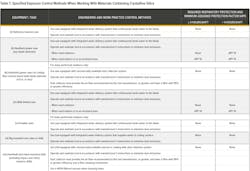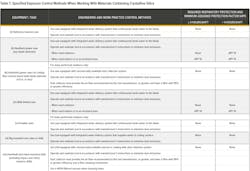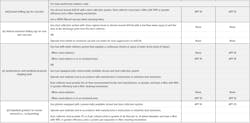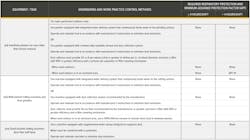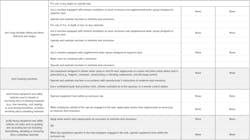Up for revision
Although extensive testing has shown that silica dust emissions from large mills are often below the OSHA Permissible Exposure Limit (PEL) for respirable crystalline silica (RCS), sometime referred to as the Silica Rule or Silica Standard, the industry is set on a course to further reduce such emissions.
Prior to the Silica Rule’s initial 2017 implementation date for the construction sector, NAPA worked diligently with its contractor members, the National Institute for Occupational Safety and Health (NIOSH), and labor to develop efficient and cost-effective engineering controls for large milling machines. After years of effort, this well-known and well-documented government-labor-industry partnership, known as the Silica/Asphalt Milling Machine Partnership, successfully developed exposure-control devices, which in 2014 mill equipment manufacturers voluntarily agreed to use starting Jan. 1, 2017. Economical retrofit kits for most mills, still in service at that time, also were made available.
During the extensive rule-making process for OSHA’s standard at the time, the agency recognized the industry’s efforts and removed the proposed rule’s requirement for milling operators and grounds crew to don respirators, eliminating all the regulatory requirements associated with an employer’s respiratory protection program.
Realizing the capital costs involved in controlling mill and other construction source emissions, NAPA extensively communicated the upcoming compliance obligations prior to the rule’s implementation. This resulted in an industry that was well prepared when the construction phase of the rule went into effect during the summer of 2017.
In 2018, NAPA similarly communicated compliance obligations associated with the general industry portion of the Silica Rule, which went into effect in summer 2018. Unlike the construction standard, which identifies “Specified Exposure Control Methods” (see Table 1 on p 47), the general industry standard requires each employer, including those operating asphalt pavement mix production facilities, to identify, document and ensure employee exposure to RCS is maintained below the PEL. Although the rule sets forth discreet compliance obligations, there are a number of well-recognized shortcomings associated with the standard.
Basic requirements
OSHA’s standard generally requires the following:
- Understand, identify and document potential employee exposure to RCS;
- Ensure employee RCS exposure is below the PEL of 50 µg/m3 as an 8-hour time-weighted average (TWA);
- Identify a “competent person” for construction-related activities (not needed under the general industry standard);
- Develop and implement a Written Exposure Control Plan (WECP) for all activities that have potential to expose employees to RCS above the Action Level;
- Identify and mark (with signage) activity areas that have the potential to exceed the PEL (general industry requirement only); and
- Ensure hazards of RCS exposure are properly communicated to employees.
Assessment and control
Although the PEL is identical for both the construction and general industry, meeting compliance obligations for each standard is a bit different. The construction standard allows certain specified exposure control methods to be implemented for certain construction-related tasks or activities, and if implemented, de facto compliance with a number of the standard’s requirements are met. For example, there are two different control methods specified for milling machine activities depending on the size of the mill. If Table 1 engineering controls are not implemented for a specified construction activity, which is acceptable, then the employer is obligated to identify typical employee RCS exposure for each activity. If employee exposure is below one-half the PEL, called the Action Level (AL), only certain and minimal compliance-related obligations are further required. However, if employee exposure is above the AL or PEL, additional monitoring or exposure control activities are required.
There are two general ways to determine whether employee exposure is below the PEL: Conduct an exposure assessment or utilize “objective data.” For the majority of road paving activities covered under the construction standard, Table 1 controls are already identified, which de facto ensures employee exposure is below the PEL. However, for those construction activities not explicitly identified in Table 1, or for any general industry activity, employees must rely on exposure assessment information. This is typically obtained through industrial hygiene (IH)-type occupational exposure assessments, surrogate monitoring, or through objective data, which could include published IH assessments, industry surveys, or other types of valid and documented exposure assessment information.
Not all road construction activities have specified Table 1 controls; e.g., dry saw cutting or dry coring activities are not specified, so to ensure exposure is below the PEL, additional exposure controls should be reviewed. This could include something as simple as blowing air across a saw cut while ensuring employees are upwind from the activity. Any non-Table 1 control used to ensure employee exposure is below the AL or PEL should be substantiated through credible data and documented in the WECP.
Because there are no Table 1-type controls specified for general industry activities like those at asphalt mix facilities, it is important to rely on appropriate exposure assessment information to understand when exposure control might be warranted. However, because PEL is time-weighted, controls may or may not be needed depending on the time allocated for such activities. For example, the rule does allow employee rotation as a method to ensure individual exposure remains below the PEL, meaning that if a certain activity has an elevated RCS exposure potential, employers are allowed to rotate employees in and out of the exposure source as a method to ensure individual employee RCS exposure remains below the PEL, averaged over an 8-hour workday. However, to utilize this type of administrative control, the employer must have credible and documented exposure assessment information that validates individual employee RCS exposure remains below the PEL.
One specified control method is the use of enclosed cabs. Additional compliance obligations are set forth under the “enclosed cab” portion of the standard. However, if an enclosed cab is not required for a Table 1 activity, employees can still use this as a control without necessarily following all the requirements set forth in the standard. For example, if the employer determines the use of an enclosed cab power broom falls outside the scope of Table 1 controls, they could still utilize an enclosed cab to protect the operator. In this case, exposure must be documented under typical operating conditions. And even though OSHA’s Enclosed Cab Standard requires use of a HEPA-like filter, other filters could certainly be utilized as long as exposure assessment documentation demonstrates that these operations or activities, with its set of specified conditional controls, maintains employee RCS exposure below the PEL.
OSHA recognizes that certain activities identified in Table 1 also may be performed at facilities that fall under the general industry standard. Unfortunately, at this time employees cannot rely on Table 1 controls for de facto compliance with similar activities, e.g., the use of jackhammers and handheld powered chipping tools requires a water delivery or dust collection system. However, this same activity at an asphalt pavement mix facility is not de facto covered under control specifications, because they do not exist for general industry activities. In this instance, the employer must demonstrate that controls used for the general industry activity (the use of a water delivery or dust collection system during jackhammering and chipping activities) ensures the operator’s RCS exposure is maintained below the AL or PEL. Another similar example is the potential use of an enclosed cab on a front-end loader or backhoe. OSHA recognizes there may be general industry activities similar to or identical to (road) construction activities for which Table 1 controls would be appropriate and protective, allowing an employer the flexibility to ensure de facto compliance for these general industry activities without conducting exposure assessment (still required under the general industry standard). It is envisioned that OSHA will address these situations when the agency provides additional compliance assistance guidance. Until that time, employees must still conduct or rely on exposure assessment information for Table 1 construction-like general industry activities to document adherence with the PEL.
2019 and beyond
Since implementation of the Silica Rule’s construction standard in 2017, and more recently implementation of the general industry standard in 2018, employers recognize certain gaps or inconsistencies with the rule—as does OSHA, and it appears the agency may be ready to rectify some of these inconsistencies.
OSHA Director of the Office of Chemical Hazards David O’Connor told Roads & Bridges, “We are looking at potential revisions of the construction standards in Table 1, adding additional controls for the activities listed there. We will be releasing a Request for Information—this will happen in the early part of 2019—in order to gather input and supporting data from industry stakeholders.”
At this point the Department of Labor has not been affected by the shutdown of the federal government, which has left OSHA cautiously optimistic about its ability to meet this time frame.
“OSHA has extensive resources to help the construction industry already in place,” O’Connor said. “We are legally obligated to post rules based on ‘substantial evidence,’ and this is what we will be looking to bolster when the Request for Information is released. We will need to satisfy that same legal standard to alter the standard as they presently stand. We’re looking to provide as much flexibility for employers as possible, while ensuring that employees are adequately protected.”
